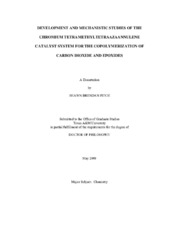| dc.description.abstract | A prominent goal of scientists is to develop products and processes to meet the
ever-growing needs of society. Today's needs include products that are economical,
specialized, and made through processes with minimal impact on the environment. One
such product that serves an important and widespread need is poly(bisphenol A
carbonate) for its physical properties and ease of synthesis and processing. However,
this polymer does not meet the growing need of being environmentally benign as
production involves carcinogenic, chlorinated solvents and toxic monomers that can
leach out from the polymer product.
An answer to this new demand is the development of a different process for the
production of polycarbonate plastics utilizing carbon dioxide and epoxides. Carbon
dioxide is an attractive monomer that is cheap and nontoxic, and its utilization signifies
an important contribution to counteract global greenhouse emissions. The stability of
carbon dioxide has posed a significant and complex challenge towards its utilization. Epoxides are attractive since they are synthesized from a wide variety of olefins, both
naturally occurring and those derived from petroleum. The exploration of catalysts to
facilitate the coupling of epoxides to carbon dioxide to afford polycarbonates has been
under investigation in the Darensbourg lab for fifteen years, and has lead to the
development of several successful systems such as zinc bisphenoxides and chromium
salens. This dissertation focuses on the development of another successful catalyst
system, chromium tetramethyltetraazaannulene, and further elucidation of the
mechanism by which polycarbonates are formed. Herein, aspects of the
copolymerization process using this system will be discussed in detail, such as cocatalyst
and pressure dependence, catalyst derivatization, and kinetic and mechanistic
investigations. The end result of these investigations is the development of the most
active chromium-based catalyst for the copolymerization of cyclohexene oxide and
carbon dioxide and a better understanding of how the copolymer product is produced. | en |


